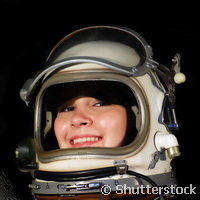EU scientists set out to tackle radiation-related gender issues in space
Why are there more men than women in space? The answer might not be as straightforward as you first think. According to physiological models used by NASA, female astronauts have a lower threshold for space radiation than their male counterparts, meaning opportunities for space exploration are more limited for them. Radiation exposure from a long time spent in deep space or on the surface of certain planets is thought to cause an increase in the probability of developing cancer. According to NASA, the added risk of a male developing cancer on a 1 000-day Mars mission lies somewhere between 1 percent and 19 percent. The odds are worse for women. In fact, because of breasts and ovaries, the risk to female astronauts is nearly double the risk to males. This means that while all astronauts are somewhat are limited in the missions they can fly, the limitations on female astronauts are far harsher. The work of the ongoing EU Project SR2S ('Space Radiation Superconductive Shield') may change this. Driven by the belief that technology can be sufficiently developed to allow both genders to withstand a long duration stay in space, SR2S aims to solve the issue of radiation protection for all astronauts within the next three years. But how can the project deliver this level of protection to radiation? According to project organisers, the SR2S superconducting shield will provide an intense magnetic field, 3 000 times stronger than the Earth's magnetic field and will be confined around the space craft. The magnetic fields will extend to about 10 metres in diameter and ionizing particles will be deflected away. Project organisers say that shielding the astronauts from ionising radiation in this way is a prerequisite to realistically plan for exploration missions to Mars, Near Earth Asteroids or for setting on the Moon surface. Speaking about the evolution of SR2S, Project leader Professor Roberto Battiston said, 'We believe we will succeed in this goal of solving the radiation protection issue. In the last few months the international teams working at CERN have solved two major technical issues relevant to the superconducting magnets in space [...] These developments open the way to larger and more effective space radiation shields and in turn facilitate deep space travel for female astronauts'. Professor Battiston added, 'Researchers must focus on both genders in current and future studies. The next exploration challenges, deep space travel to Near Earth Asteroids and long duration stay on Mars and on the moon, require an effective way to actively shield astronauts.' SR2S, which began in January 2013, comprises an impressive research team drawn from top institutes around Europe: Istituto Nazionale di Fisica Nucleare (INFN), CERN, Compagnia Generale per lo Spazio (CGS SpA), Columbus Superconductor SpA, Thales Alenia Space - Italia S.p.A. and Commissariat à l'énergie atomique et aux énergies alternatives (CEA).For more information, please visit: SR2S http://www.sr2s.eu/ Project factsheet
Countries
Italy



